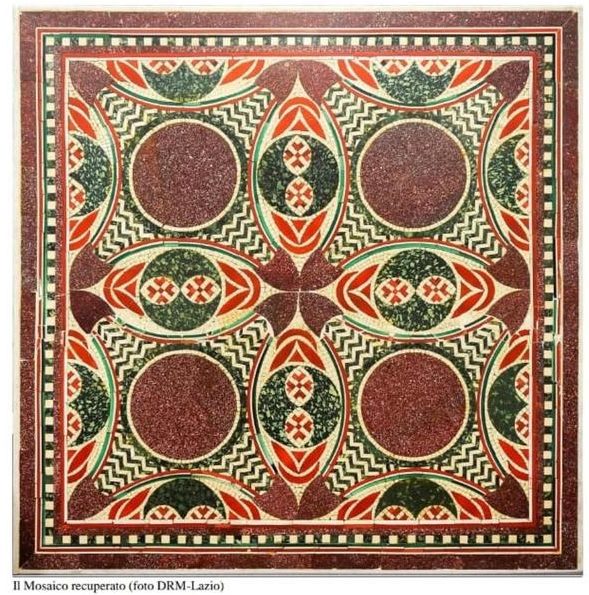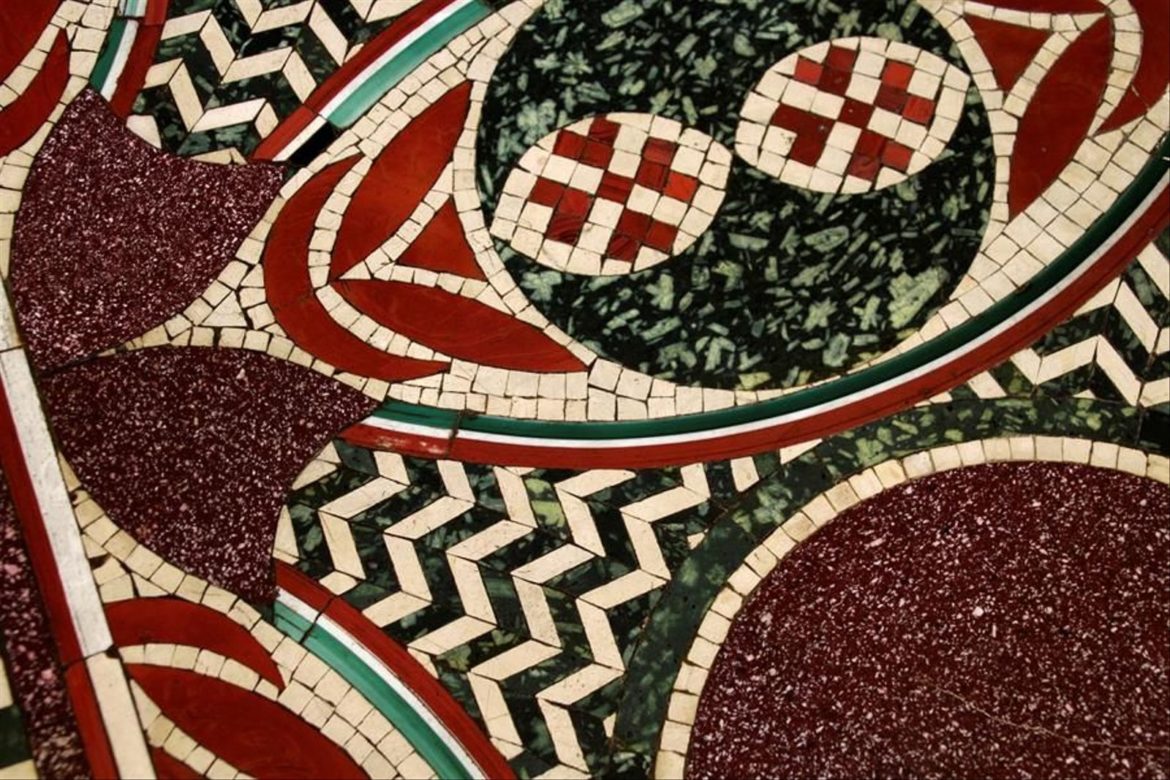
NEMI, Italy – A plundered mosaic that decorated the famous floating palaces built by the Roman emperor Caligula has been recovered, restored, and returned to the Museum of the Nemi Ships (Museo delle Navi Romane di Nemi) in Nemi, Italy. The mosaic was unveiled on Thursday at a ceremony commemorating its return. The first century mosaic had been converted to a coffee table and was found in a private collection in New York City.
The mosaic was found thanks to the work of Italy’s specialized police force, the Carabinieri Tutela Patrimonio Culturale (TPC), which locates lost and stolen antiquities. Founded in 1969, the TPC is the first such police in the world. Its four divisions focus on archaeology, antique dealing, counterfeits, and contemporary art. The TPC also has specialized teams that protect and recover tangible cultural objects in disaster areas.
The TPC has a vast network of relationships that include universities, research centers, museums, and law enforcement partners around the world. It also works closely with ecclesiastical organizations and non-governmental agencies like the United Nations Educational, Scientific, and Cultural Organization (UNESCO) to maintain a database of trafficked and missing art and antiquities.
The mosaic was part of the Nemi ships, which are best imagined as barges. One barge appears to have served as a temple to Diana, whom Caligula may have understood as an aspect of the Egyptian goddess, Isis. Another, larger barge served as a pleasure palace.
The town of Nemi is famous for the cult and temple of Diana Nemorensis located in a sacred grove, nemus meaning “grove” or “holy wood.” The area figures prominently in James Frazer’s seminal work, The Golden Bough. Lake Nemi, into which the ships were sunk, is found within a volcanic crater and is called “The Mirror of Diana.” The remains of the ancient temple of Diana Nemorensis still stand along the lake’s shore and are currently the target of continued excavation. There are plans to open the area in the future to the public.
The mosaic was first discovered in 1895 CE during an early excavation of the Nemi ships area by archeologist Eliseo Borghi. The last known reference to the mosaic is a photo from 1955, later published in Porphyry, a book by Professor Dario Del Bufalo, an expert on ancient marbles.

The mosaic among items in the Borghi excavation [public domain]
At some point after 1955, the mosaic ended up on New York City’s Park Avenue in the collection of Nereo Fioratti, a journalist with Italy’s newspaper Il Tempo, and his wife Helen Fioratti, who is an art collector.
Del Bufalo, who attended the return of the mosaic to the museum last week, recounted presenting his then-new book featuring the mosaic photo to art experts at the Bulgari jewelry store on Manhattan’s 5th Avenue in 2013. “I was sitting there signing books, and suddenly people started saying, ‘Oh look, isn’t that Helen’s coffee table?’ when they got to the photo of Caligula’s lost mosaic,” he told The Daily Beast. “It wasn’t just one person, but it seemed everyone had seen the table.”

The recovered mosaic [Courtesy for editorial use: Museo delle Navi Romane]
Fioratti’s coffee table was actually quite famous. It had been featured in the journal Architectural Digest in 2011. Del Bufalo promptly told the TPC.
The Fiorattis purchased the green and white glass and marble mosaic from an aristocratic Italian family in the late 1960s in a sale facilitated by an Italian police officer. “It was an innocent purchase,” Helen Fioratti told The New York Times in 2017. “It was our favorite piece and we had it for 45 years.” How the mosaic passed into private hands prior to the Fioratti purchase is unclear.
After a four-year investigation, the Manhattan district attorney’s office seized the mosaic at the request of the TPC in October of that year.

A close up of the mosaic, showing stones in white, green, and red patterns [Courtesy for editorial use: Museo delle Navi Romane]
Italy’s National Museum Director Massimo Osanna said that the mosaic appears to have been smuggled out of Italy. The mosaic had no provenance, no receipt or import papers.
Helen Fioratti did not fight the seizure of the table, instead noting that she should have been rewarded for taking good care of the mosaic while it was in her apartment. Fioratti, now in her 90s, was not charged with any criminal activity.
“These items may be beautiful, storied, and immensely valuable to collectors,” said Manhattan District Attorney Cy Vance in a 2017 statement, “but willfully disregarding the provenance of an item is effectively offering tacit approval of a harmful practice that is, fundamentally, criminal.”
At the return of the mosaic, Osanna noted that Italian antiquities specialist restorers have been working over the last four years to remove “remnants of domestic life” from its surface, including coffee and tea stains, as well as calcium markings from flower vases and cocktails. “It was clearly a well-used table,” he said.
Unfortunately, the conversion of the mosaic to a coffee table destroyed the details of how the mosaic had been originally constructed.
Alberto Bertucci, the mayor of Nemi, was also present at the return of the mosaic to the museum. He shared his excitement at the return of the mosaic and thanked Osanna for his team’s efforts. “It is a memorable day in our town,” Bertucci said. “The mosaic belonging to the command bridge of the Emperor Caligula’s ship, stolen and recovered in New York by the Carabinieri Cultural Heritage Protection Command, is now permanently exhibited in the Museum of Roman Ships in Nemi.”
The Wild Hunt is not responsible for links to external content.
To join a conversation on this post:
Visit our The Wild Hunt subreddit! Point your favorite browser to https://www.reddit.com/r/The_Wild_Hunt_News/, then click “JOIN”. Make sure to click the bell, too, to be notified of new articles posted to our subreddit.